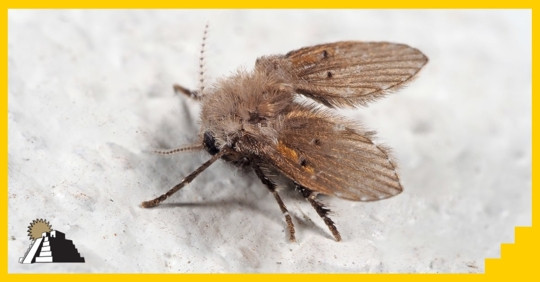Have you noticed tiny, fuzzy flies buzzing around your sinks, showers, or drains? If so, you’re likely dealing with drain flies, also known as moth flies or sink flies. These small pests are more than just a nuisance; their presence often signals underlying issues within your plumbing system. Understanding why drain flies appear in your home is the first step towards effectively eliminating them.
 Close-up of a drain fly, also known as a moth fly, highlighting its fuzzy body and wing characteristics. These pests are common in homes and indicate potential drain issues.
Close-up of a drain fly, also known as a moth fly, highlighting its fuzzy body and wing characteristics. These pests are common in homes and indicate potential drain issues.
Drain flies are attracted to stagnant, organic-rich environments, and unfortunately, your drains can be the perfect breeding ground. With a rapid life cycle, a few drain flies can quickly multiply into a significant infestation if left unaddressed. Let’s delve into the common reasons behind drain fly infestations and explore how to reclaim your home from these unwanted guests.
Common Culprits Behind Drain Fly Infestations
Several factors can contribute to drain fly problems in your home. Understanding these causes is crucial for targeted prevention and elimination.
1. Easy Access Points into Your Home
Despite their small size, drain flies can easily enter your home through various openings. Just like other insects, they can slip through gaps around doors and windows, unsealed cracks, and other entry points. They are drawn to sources of standing water and moisture, which often leads them indoors.
2. The Allure of Your Drain Pipes
Your drain pipes are prime real estate for drain flies. They are particularly attracted to the moist environment and the buildup of organic matter, bacteria, and grime that accumulates within drain lines. This organic sludge provides the perfect food source and breeding ground for these flies. Standing water, even in infrequently used drains, creates an ideal habitat for them to thrive and reproduce. If you’ve been away from home or have drains in guest rooms or basements that aren’t used regularly, these are often the first places you might notice drain fly activity.
3. Clogged Drains and Sewage Backup
Clogged drains are a major attractant for drain flies. Trapped sewage and accumulated waste within a clog provide an abundant food source and breeding site. Drain flies are particularly fond of sewage and will readily infest clogged pipes. This highlights the importance of addressing drain clogs promptly, not just to restore proper drainage but also to prevent pest infestations.
What Exactly Are Drain Flies?
Drain flies are small insects, typically less than 5 millimeters long, belonging to several species. Often mistaken for gnats or fruit flies at first glance, a closer look reveals their distinctive features. They are covered in fine hairs, giving them a fuzzy appearance reminiscent of moths – hence the name “moth flies.”
Identifying Drain Flies: Key Characteristics
While they might resemble other small flying insects, drain flies have unique characteristics:
- Fuzzy Bodies: Their bodies are covered in hair, giving them a fuzzy or moth-like appearance.
- Flat Wings: Unlike fruit flies, drain flies have wings that are held flat over their bodies when at rest, giving them a broader, moth-like silhouette.
- Color: They are typically gray or tan in color.
- Habitat: Their consistent presence around drains is a strong indicator, as they breed and feed within drain systems.
Despite their unhygienic habitat, drain flies are not considered a direct health threat. However, they are certainly a nuisance, especially in kitchens and food preparation areas, where they can potentially contaminate surfaces with bacteria from the drains.
Their rapid reproduction rate, with a life cycle of about 48 hours for egg to adult and a lifespan of up to three weeks, means that a small drain fly issue can quickly escalate into a full-blown infestation if ignored.
Treatment and Prevention Strategies
Completely preventing drain flies can be challenging, but significantly reducing their presence is achievable with consistent drain maintenance and targeted treatment methods.
Preventative Measures: Keeping Drains Clean
The best defense against drain flies is maintaining clean drains. This involves preventing the buildup of organic matter that attracts them.
- Avoid Drain-Clogging Habits: Be mindful of what goes down your drains. Avoid pouring coffee grounds, rice, solid food scraps, hair, and other clog-inducing materials into sinks and drains.
- Regular Drain Cleaning: Flush drains regularly with hot water to help prevent buildup.
Addressing Existing Infestations: Treatment Options
If drain flies have already taken residence, addressing the breeding sites is key to effective elimination.
- Target Breeding Sites: Focus on cleaning the drain pipes where they breed. The organic slime and buildup inside pipes are the primary attractants and breeding grounds.
- DIY Drain Cleaning Methods:
- Boiling Water: Pouring boiling water down the drain can help dislodge some organic matter.
- Baking Soda and Vinegar: A mixture of baking soda and vinegar followed by hot water can also help clean drains. Pour 1/2 cup of baking soda down the drain, followed by 1 cup of vinegar. Let it fizz for 30 minutes, then flush with hot water.
- Avoid Chemical Drain Cleaners and Pesticides: While readily available, chemical drain cleaners are often harsh and can damage pipes. Pesticides should never be poured down drains as they can contaminate water systems and are not an effective solution for drain flies breeding inside pipes.
Professional Drain Cleaning: A Comprehensive Solution
For persistent drain fly infestations or stubborn clogs, professional drain cleaning services offer the most comprehensive solution. Professionals have the tools and expertise to thoroughly clean drain lines, removing the organic buildup that attracts and sustains drain flies.
Whether you’re battling an active drain fly infestation or struggling with a persistent clog, Aztec Plumbing & Drains provides expert drain cleaning services. Contact our knowledgeable team today at 239-932-2959 for effective and lasting drain solutions.